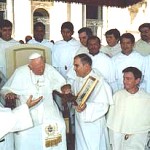 What do we know about the women religious in the United States who made their final vows this past year?
What do we know about the women religious in the United States who made their final vows this past year?
Plenty!
The Center for Applied Research in the Apostolate (CARA) released a report last week on the women who professed perpetual vows in 2010. This report, commissioned by the Secretariat of Clergy, Consecrated Life, and Vocations of the United States Conference of Catholic Bishops (USCCB), contains an overwhelming amount of statistics and demographic data.
Here, I will provide a “top ten” list of findings that I found most significant:
(1) 77% of the sisters have three or more siblings (the average was five), while only one sister reported being an only child.
Need I say any more about the critically important role of large Catholic families as fertile ground for religious vocations? The generosity of Catholic parents who are open to life speaks volumes to their children.
(2) Prayer matters.
74% had attended a retreat prior to entering the community, and two-thirds of them prayed the Rosary and participated in Eucharistic adoration on a regular basis before entering religious life. While this is a positive stat, I hope that the other one-third picked up these religious practices after they joined!
(3) 52% reported that they were encouraged by other religious to consider religious life.
And nine out of ten reported that they were encouraged by someone in their life. This stat shows the importance of inviting others to “come and see,” and of supporting them in their discernment process. This is especially important in light of the next item.
(4) 66% reported that they were discouraged from considering a vocation by one or more persons.
Even more, 51% reported that they faced opposition within their own families! It makes one wonder how we can make families a more hospitable seedbed for vocations. Certainly a renewal of faith and sense of vocation among Catholic parents is crucial if we are to reverse this trend.
(5) 78% had already completed some college, and 59% had already graduated from college at the time they entered the religious institute.
The new sisters are well-educated, not only for work in education or health care, but other fields as well. The one balancing factor is that this goes hand in hand with older vocations, as the median age of the sisters is 44.
(6) Kudos to Franciscan University!
Six percent reported that a youth conference at Franciscan University of Steubenville played a role in their religious vocation. Makes me proud to be an alumnus.
(7) World Youth Day.
A staggering 20% of the sisters reported that they participated at a World Youth Day prior to entering their religious community. Memo to pastors: Keep these pilgrimages in the budget!
(8) The median age at which the sisters began considering a possible vocation to religious life was 18.
The mean was 20, as some older vocations skewed the average. This points to the critical importance of college campus ministry and evangelization programs like the Fellowship of Catholic University Students (FOCUS).
(9) 51% attended Catholic elementary school and 25% attended Catholic high school.
This figure isn’t that impressive to me. Where did all the others go? At some point, it would be useful to distinguish between those who were homeschooled by Catholic parents versus those who attended public or non-sectarian private schools.
Still, the figures here are above the national averages for Catholics in the United States. Since Catholic schools continue to be such a significant source of religious vocations, the ongoing religious formation of Catholic school teachers must be a priority. Also, in light of (3), I think the more religious we have in the Catholic schools, the more likely it is that the school will foster religious vocations.
(10) 84% of superiors reported no new religious professions, and another 13% reported only one.
That means 311 of the communities that participated in the survey did not have anyone take final vows. Many of those communities are aging and have not had many vocations in recent years. While it’s a fact of Church life that some religious communities die out and others spring up, I found the numbers this year a bit sobering. So let’s get busy, people! All of us have the duty to pray for vocations to the religious life, and to support those who have already entered.
Beyond all the numbers, though, the most important consideration is that we have all these beautiful sisters who have now consecrated their lives completely to Christ. What a blessing for them, and for the Church!
Like this:
Like Loading...
 Very few of us will walk up to someone today and greet him or her with the words, “Happy St. Cyril’s Day,” or even “Happy Cyril’s Day.” And surely no one will tell their sweetheart to “Be my Methodius.”
Very few of us will walk up to someone today and greet him or her with the words, “Happy St. Cyril’s Day,” or even “Happy Cyril’s Day.” And surely no one will tell their sweetheart to “Be my Methodius.”

 The current issue of the Homiletic and Pastoral Review has an outstanding article by Fr. Damien Ference entitled,
The current issue of the Homiletic and Pastoral Review has an outstanding article by Fr. Damien Ference entitled, 
 What do we know about the women religious in the United States who made their final vows this past year?
What do we know about the women religious in the United States who made their final vows this past year? Pope Benedict XVI devoted his weekly general audience last Wednesday to St. Teresa of Avila (1515-82), one of the most revered spiritual guides in the history of the Church.
Pope Benedict XVI devoted his weekly general audience last Wednesday to St. Teresa of Avila (1515-82), one of the most revered spiritual guides in the history of the Church.  At the conclusion of his general audience this past Wednesday, Pope Benedict XVI recalled that February 2nd was also
At the conclusion of his general audience this past Wednesday, Pope Benedict XVI recalled that February 2nd was also  I just received this invitation from the Poor Clares of Perpetual Adoration in Arizona. This is a worthy cause and hey, if you don’t live too far from Tempe, consider joining the fun!
I just received this invitation from the Poor Clares of Perpetual Adoration in Arizona. This is a worthy cause and hey, if you don’t live too far from Tempe, consider joining the fun! (1) Please
(1) Please  Today the Church is celebrating the World Day for Consecrated Life simultaneously with the Feast of the Presentation of the Lord in the Temple. Pope Benedict XVI is observing the two celebrations by presiding over Vespers in St. Peter’s Basilica this evening.
Today the Church is celebrating the World Day for Consecrated Life simultaneously with the Feast of the Presentation of the Lord in the Temple. Pope Benedict XVI is observing the two celebrations by presiding over Vespers in St. Peter’s Basilica this evening. It is no accident that the event coincides with the celebration of the Feast of the Presentation of the Lord in the Temple. This celebration, wrote Venerable John Paul II, is an “eloquent icon of the total offering of one’s life for all those who are called to show forth in the Church and in the world, by means of the evangelical counsels ‘the characteristic features of Jesus — the chaste, poor and obedient one.’ ”
It is no accident that the event coincides with the celebration of the Feast of the Presentation of the Lord in the Temple. This celebration, wrote Venerable John Paul II, is an “eloquent icon of the total offering of one’s life for all those who are called to show forth in the Church and in the world, by means of the evangelical counsels ‘the characteristic features of Jesus — the chaste, poor and obedient one.’ ”